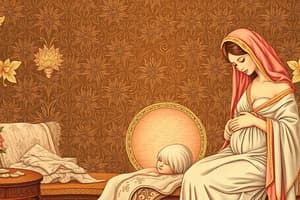Podcast
Questions and Answers
What starts the positive feedback loop of childbirth labor?
What starts the positive feedback loop of childbirth labor?
This cycle begins when the child enters the cervix and stretches the muscle wall.
Describe the positive feedback loop between cervical stretch receptors, neurosecretory cells in the hypothalamus, oxytocin, and the uterine smooth muscle.
Describe the positive feedback loop between cervical stretch receptors, neurosecretory cells in the hypothalamus, oxytocin, and the uterine smooth muscle.
When the child enters the cervix it stretches, which sends impulses to the brain, triggering oxytocin release, causing uterine contractions that push the child further into the cervix.
How is this positive feedback loop terminated?
How is this positive feedback loop terminated?
The birth of the child reduces and eliminates stimuli to the pressure sensitive receptor cells.
Describe the importance of homeostatic body temperature maintenance.
Describe the importance of homeostatic body temperature maintenance.
What is the function and locations of thermoreceptors?
What is the function and locations of thermoreceptors?
Explain the negative feedback control of body temperature using thermoreceptors, the hypothalamus, and the temperature control center.
Explain the negative feedback control of body temperature using thermoreceptors, the hypothalamus, and the temperature control center.
How is homeostasis maintained under heat stress?
How is homeostasis maintained under heat stress?
How is homeostasis maintained under cold stress?
How is homeostasis maintained under cold stress?
Explain how high or low blood pressure affects capillary blood flow.
Explain how high or low blood pressure affects capillary blood flow.
What is the function of baroreceptors?
What is the function of baroreceptors?
Explain the negative feedback loop between baroreceptors, the cardiovascular center, and the heart.
Explain the negative feedback loop between baroreceptors, the cardiovascular center, and the heart.
Flashcards are hidden until you start studying
Study Notes
Positive Feedback in Childbirth
- Positive feedback loop in childbirth starts when the child enters the cervix, stretching its muscle wall.
- Cervical stretch receptors detect the stretch, sending impulses to the hypothalamus.
- Neurosecretory cells in the hypothalamus release oxytocin into the bloodstream, which stimulates uterine contractions.
- Increased contractions push the child further into the cervix, stretching it more and reinforcing the cycle until birth.
Termination of Positive Feedback
- Birth of the child eliminates stimuli to cervical receptors, halting impulses to the hypothalamus.
- Without stimuli, production of oxytocin stops, terminating the positive feedback loop.
Importance of Homeostatic Body Temperature
- Maintaining body temperature is crucial to avoid disorders like cardiac arrhythmias.
- Body temperature regulation requires balancing heat loss with heat production.
Function and Locations of Thermoreceptors
- Thermoreceptors are distributed throughout the body, detecting temperature changes.
- They send temperature information to the brain via neural impulses.
Negative Feedback Control of Body Temperature
- The anterior hypothalamus contains neurons that maintain heat balance.
- Neurons in the pre-optic area integrate signals from thermoreceptors for temperature regulation.
- In cases of overheating, the hypothalamus stimulates the heat loss center and inhibits heat production.
Homeostasis Under Heat Stress
- Increased temperature is sensed by thermoreceptors that signal the hypothalamus.
- Skin blood vessels dilate, allowing more blood near the skin surface for cooling.
- Sweat production is stimulated, aiding in evaporative cooling of the skin.
Homeostasis Under Cold Stress
- In cold environments, the anterior hypothalamus activates heat-producing mechanisms.
- Shivering in skeletal muscles generates heat, while blood vessel constriction minimizes heat loss.
- This dual response effectively restores temperature homeostasis.
Blood Pressure Effects on Capillary Flow
- Decreased blood pressure reduces capillary pressure, limiting blood flow and potentially causing inadequate perfusion.
- Increased blood pressure may overstretch capillary walls, risking rupture.
Function of Baroreceptors
- Baroreceptors monitor blood pressure, located in the aortic arch and carotid arteries.
- They sense vessel stretching and send impulses to the brain's regulatory centers.
Negative Feedback Loop in Blood Pressure Regulation
- Baroreceptors act as sensors for blood pressure changes, relaying information to the cardiovascular center.
- A drop in blood pressure triggers stimulation of the heart and hormonal mechanisms for vessel constriction.
- This coordinated response aims to restore blood pressure to homeostatic levels.
Studying That Suits You
Use AI to generate personalized quizzes and flashcards to suit your learning preferences.




